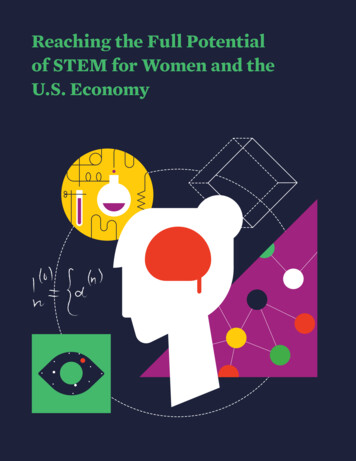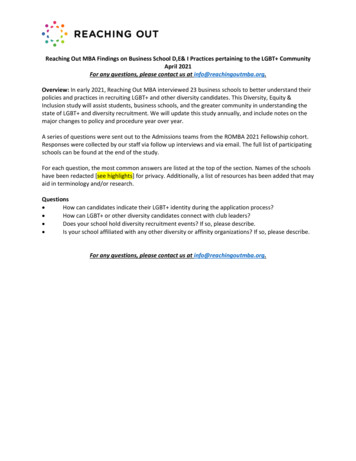
Transcription
Reaching the Full Potentialof STEM for Women and theU.S. Economy112
Reaching the Full Potentialof STEM for Women and theU.S. Economy2Reaching the Full Potential of STEM for Women and the U.S. Economy
Somewhere in America there is a techexecutive looking for a skilled programmer.Somewhere else there is a young girl on acomputer tablet learning to code.It’s about time these two got acquainted.Across the country, companies are looking to hire people with skills in science, technology,engineering, and mathematics. But there remains a shortage of talented women in thesefields, and this poses a threat to our competitiveness as a nation. That’s why I am pleased topresent the Center for Women in Business’ new report Reaching the Full Potential of STEM forWomen and the U.S. Economy,The argument for more women in STEM careers is simple. Projections show that America willneed to fill 6.6 million STEM jobs over the next 10 years. Although women are becoming moreeducated than ever before—making up half of all workers with postsecondary degrees—theycompose just 25% of workers in STEM fields. How can companies find enough STEM workersif half our population is directed toward other professions? How can our nation compete if weare not luring the brightest minds into STEM fields?Bringing more women into the STEM workforce is not just about gender equity. Women inSTEM are essential for building a strong economy and a bright future for American enterprise.In a competitive global economy, we need STEM workers to solve our companies’ toughestproblems in new, creative ways. A diverse workforce keeps our perspectives fresh and ourideas innovative. That’s why we need more female voices in all STEM positions, from entrylevel app designers to technology executives.We must motivate young girls to pursue an interest in science and mathematics and teachthese subjects in ways that are compelling. We need mentoring programs that support womenand girls in STEM fields. We must change work cultures to inspire more women to lead.I encourage you to read this report and consider the ways we can bring more women into theSTEM economy. Advancing women in STEM fields is not just about women. It’s about creating the best workforce possible and boosting our nation’s competitiveness along the way.Roberta Phillips, Executive DirectorCenter for Women in BusinessU.S. Chamber of Commerce Foundation5
AbstractTable of ContentsScience, Technology, Engineering, and Mathematics (STEM)are essential to the U.S. economy and to sustainable long-termeconomic growth. STEM education and STEM employmentare both crucial. The demand for STEM workers in the UnitedStates across industries is expected to grow faster than otheroccupations in the next decade.8Contributors9Executive SummaryWomen account for half of the labor force, yet they account foronly one-quarter of core STEM jobs. Although the participationrates of women in STEM education and occupations have beenrising over the past decades, women are still underrepresentedin the core STEM fields.33 AppendixAdditional public and private initiatives and programs arenecessary to encourage women to enter and stay in STEMfields in order to fulfill the demand for STEM workers.37 About Us6Reaching the Full Potential of STEM for Women and the U.S. Economy13 Reaching the Full Potential of STEM forWomen and the U.S. Economy35 Endnotes37 About the Authors7
ContributorsDr. Leonard BellAlexion PharmaceuticalsP. GopalakrishnanIBMExecutiveSummarySarah FriarSquareMaria KlaweHarvey Mudd CollegeSTEM education is critical to ensure a highly effective and competitive workforce. Formaltraining provides the advanced skills and knowledge necessary for scientists, technologists,engineers, and mathematicians to excel in their jobs. It is also effective training for those whochoose non-STEM occupations in the fields of business, law, accounting, and teaching. TheUnited States must continue to invest in human capital and STEM education in order to stayglobally competitive, infusing this training in K-12 programs and continuing through postsecondary studies.Patricia ElizondoXerox CorporationMarillyn A. HewsonLockheed MartinSkill sets in science, technology, engineering, and mathematics (STEM) are essential for ensuring long-term sustainable economic growth. The United States continues to lead in scienceand technology, accounting for 40% of global research and development (R&D) investmentand employing a third of the world’s scientists and engineers. STEM graduates work in a widerange of jobs. They contribute to manufacturing and the services industry. They are scientistsin laboratories, engineers in manufacturing firms, nurses in hospitals, and teachers inschools, to name a few.Susan PugliaIBMWomen continue to be underrepresented in STEM careers, even as they account for half ofthe college-educated employees in the workforce. Although the educational attainment ofwomen and their prominence in the workforce have grown steadily over the past decades,women are still lagging behind in STEM education and occupations compared with men. Thisleaves an unfortunate gap in the STEM workforce that prevents the American economy fromreaching its full potential, and our nation’s long-term competitiveness may suffer as a result.It also leads to a lack of diversity in organizations. Diverse organizations can be more successful and profitable. In addition, women are missing out monetarily since wages of STEMjobs are higher than those of non-STEM occupations. For these reasons, the U.S. Chamberof Commerce Foundation Center for Women in Business has embarked upon this researchproject to investigate the state of women in STEM education and occupations and how toincrease these numbers.More than 6.6 million STEM jobs need to be filled by 2022, which outpaces the growth rate ofnon-STEM jobs by about 6%. Public policy initiatives and private programs are necessary toencourage young girls and women to pursue these opportunities.Susan MolinariGoogleReshma SaujaniGirls Who CodeGwynne ShotwellSpaceXThis report examines the participation of women in STEM education and occupations overthe past decades in the United States. It also provides insights from a survey of leading experts in academia, government agencies, private companies, and nonprofit organizations toidentify ways to attract women to STEM fields.Here are some key statistics and findings of the report:Since 1980, women have surpassed men in postsecondary education. In particular, the number of women graduating with science and engineering degrees has been increasing at a faster rate than their male counterparts over the past decades. Despite this trend, the number ofwomen students and graduates in science and engineering fields still represents a very smallshare of the female student body.Margaret SpellingsGeorge W. Bush Presidential CenterDebbie SterlingGoldieBloxDr. Kathryn SullivanNOAAVivek WadhwaStanford UniversityFemale enrollment has increased by 239% since 1970 to account for nearly57% of total enrollment in postsecondary educational institutions in 2013.During the period from 1990 to 2013, female graduates in physical sciences, technology, engineering, mathematics, statistics, and computer science, referred to in this report as core STEM fields, increased by 130%compared with only a 76% increase of male graduates in these same fields.Telle WhitneyAnita Borg Institute8Maggie WilderotterFrontier CommunicationsReaching the Full Potential of STEM for Women and the U.S. EconomyMarco ZappacostaThumbtack, Inc.9
The growth rates for women in broader STEM fields, including social sciences and healthcare, were even higher.The number of female graduates in core STEM fields accounted for only 6% of totalfemale graduates in 2013 (165,442 out of 2.65 million total graduates). That same year,20% of male students graduated in these fields (369,792 out of 1.88 million total graduates).With more women graduating each year, women now represent about half the total workforce with postsecondary education. Given the growing demand for STEM jobs—and the increasing number of womenwith STEM degrees—more women have gravitated toward STEM occupations over the past 20 years, especially in the health care industry.However, women are still significantly underrepresented in core STEM occupations, such as physical scientists, technologists, engineers, programmers, and mathematicians. Women are also underrepresentedin executive and high-level management positions held by STEM-educated individuals.The number of STEM jobs increased by 21% more than non-STEM jobs, from 6.1 millionin 1993 to 11.2 million in 2010. About 57% of those STEM jobs were core STEM and 43% wereSTEM-related jobs, including architecture and health care jobs where women are highlyrepresented.The participation of women in STEM jobs more than doubled over the past 20 years,largely in the health care industry. Indeed, the number of women working in core STEM jobsincreased by 89% and in STEM-related jobs by 139%, both higher rates than for men.While accounting for 43% of total STEM jobs, women accounted for only one-quarterof core STEM jobs. In fact, only one-third of women in STEM occupations are in core STEMjobs, while three-quarters of men in STEM are in core STEM occupations.Our survey of leading STEM experts found that encouraging women to gain an interest in STEM starts atan early age and continues throughout their careers. For instance, mentoring girls and women in STEMfields can have a sizeable impact. In addition, fostering an inclusive culture in academia and the workplace,as well as developing programs that support women as they work to achieve their professional goals, canhelp retain and advance women in STEM careers. Both public and private programs are well placed to implement these initiatives.In sum, more women are needed in STEM fields, particularly because of the field’s significance to the advancement of women and the competitiveness of the American economy. More programs and initiativesare needed to encourage girls to study science and engineering and to promote women to enter and remainin STEM fields in which they are still underrepresented.10Reaching the Full Potential of STEM for Women and the U.S. Economy11
Reaching the Full Potential of STEMfor Women and the U.S. EconomySTEM, Innovation, and Economic GrowthThe United States has been a leader in science and technology over the past 50 years. TheUnited States accounts for 40% of worldwide research and development investment andemploys nearly one-third of the world’s scientists and engineers. Furthermore, American universities and colleges attract the most accomplished and promising young students across theglobe. Innovation and economic growth are inextricably linked to one another. Innovation hasdrastically transformed the American economy since the Industrial Revolution by increasingproductivity, connecting companies to a wider range of customers, and raising the standardof living. A strong innovation pipeline is essential to continue introducing technologically newand creative products and services into the market. 2“There are women in key leadership positions, but we are missing women in importantmiddle management roles. That is the test bed; that is where you create new leaders.To populate that, you need to have more women as new employees. There is no question that women are starting to enter engineering programs at a much higher rate.If you are increasing the pool of new graduates who are women, that will filter up. Ithink it is important to speed up the process a little bit.”3— Gwynne Shotwell, President and Chief Operating Officer, SpaceXThe impact of innovation and related skill sets on economic growth has been a key focus ofpublic policy initiatives in recent years. Studies have found strong evidence to support thelinkages of higher levels of education, training, skills, and innovation to the economic performance of companies, industries, and countries. A primary focus of these studies is the relationship between R&D and innovation, documenting the extent to which scientific researchhas been the dominant driver of innovation. 4 While innovation is still heavily reliant on basicscientific research, it is more broadly influenced by disciplines such as social science, healthcare, and sales. 5STEM workers are crucial drivers of long-term sustainable economic growth, and their expertise is needed beyond technology companies and research firms. In fact, STEM employees arefound across all industries including agriculture, mining, utilities, manufacturing, wholesalers,and services. Moreover, employees with STEM backgrounds are working across differentoccupational functions, for example, R&D personnel, managers, educators, and technicalsalespeople. STEM employees create innovative ideas and commercialize new products andservices. Introducing these new products into the market, in turn, creates more jobs andboosts the overall workforce and economy.“Women want STEM jobs where“Women want STEM jobs wherethey MATTER to people, communities,they MATTER to people, communities,business and government.”business and government.”“STEM is important for two reasons. First, the solutions to many of the importantchallenges facing the world rely on knowledge, skills, and advancements in STEMfields. Second, the economic future of the U.S. and the world increasingly depends onproducing enough graduates in some STEM areas, particularly in fields related to information technology and computer science.”— Maria Klawe, President, Harvey Mudd College— Dr. Kathryn Sullivan, Administrator and Under Secretary of Commerce for Oceans and Atmosphere,— Dr. KathrynSullivan,Administratorand Under Secretaryof Commercefor Oceans and Atmosphere,NationalOceanicand AtmosphericAdministration(and a formerNASA Astronaut)National Oceanic and Atmospheric Administration (and a former NASA Astronaut)1212Success in STEM and in the U.S. EconomyReaching the Full Potential of STEM for Women and the U.S. Economy13
While occupations are inherently dynamic and job responsibilities change over time, a majorfocus is placed on STEM education as a means to increase innovation. Colleges and otherpost graduate institutions are essential producers of skilled workers. Students from aroundthe world travel to the United States to attain a world-class education and training in STEMfields. An Organisation for Economic Co-operation and Development (OECD) study showsthat a strong relationship exists between human capital development and higher educationinstitutions, and that innovation clusters in regions highly concentrated with skilled and creative workers.6 A formal STEM education leads to a higher degree of critical thinking and animprovement in problem-solving skills.7 STEM education helps instill an innovative mind-setthat leads to creative new ventures and increased economic growth.While women represent more than half of postsecondary enrollment and graduates, theycontinue to be underrepresented in STEM education and STEM occupations. This leaves anunfortunate gap that prevents the U.S. economy from reaching its full potential. Publicpolicies as well as private initiatives are needed more than ever to encourage women to enrollin STEM education fields, and to ensure that they have the appropriate opportunities to pursue, and remain in, STEM occupations. STEM occupations are projected to grow at a fasterrate than non-STEM jobs over the next decade and will contribute directly to our economicgrowth through greater innovation and increased competitiveness.“STEM is important because it is the basis of manytechnologies that are advancing rapidly and makingit easier to solve humanity’s problems. It providesa foundation for learning about computers, science,engineering, and so on.”— Vivek Wadhwa, Fellow, Stanford UniversityAnalytical Approach of the ReportThis report examines the participation of women in postsecondary STEM education andSTEM occupations. Since STEM fields have evolved over the years, the definition of STEM hasalso expanded beyond traditional categories of science, technology, engineering, and mathematics. Our analyses therefore include both core STEM and broader STEM-related fieldsto provide a more complete landscape. Our quantitative analyses are based on official datapublished by U.S. government agencies. Our qualitative analysis is based on an interview-stylesurvey of executives and subject-matter experts.The first part of the report analyzes the participation of women in education. We used enrollment and graduation data from the U.S. Department of Education and the National ScienceFoundation. The analysis identifies the number of women enrolled in postsecondary education,as well as those majoring and graduating specifically in STEM fields of study. We follow threemain classifications of STEM fields of study defined by the U.S. Department of Education’sNational Center for Education Statistics (NCES), the U.S. Department of Homeland Security(DHS), and the National Science Foundation (NSF). We apply the NCES classification todiscuss core STEM education while relying on the NSF classification to analyze STEM-related14Reaching the Full Potential of STEM for Women and the U.S. Economyeducation that goes beyond science, technology, engineering, and mathematics. See the Appendix for further discussion on our classification of STEM fields.The second part of the study analyzes the participation of women in STEM occupations. Weused employment data published by the NSF. The dataset is based on the NSF survey thatlinks occupations of postsecondary graduates to their field of study. We adopt the classification of STEM occupations defined by the STEM working group that includes representativesof federal agencies and approved by the Office of Management and Budget. We usedemployment data and projections by industries from the U.S. Bureau of Labor Statistics of theDepartment of Labor. While health care jobs are considered STEM occupations by the workinggroup, health education is generally not considered as a STEM field of study.The report includes direct quotes from senior executives and noted subject-matter expertsin academia, government agencies, and private corporations. We conducted these interviewsurveys in November and December 2014 to obtain these experts’ views on the developmentof women in STEM fields of study and STEM occupations. Their quotes amplify our findingthat much more needs to be done to attract women into STEM education and occupations.We also summarize various public and private initiatives to promote women in STEM fieldsthat surfaced from our survey.Women in STEM Fields Of Study“Tech companies are about building nonhuman solutions to life’s problems, but werely on people to build those solutions. We desperately need to make sure we doing everything we can to attract and retain the best people on the planet to fill those roles.”— Marco Zappacosta, CEO and Co-Founder, Thumbtack, Inc.Female postsecondary enrollment across all fields of study has outpaced male enrollment since 1980, registering 57% of the 21.1 million postsecondary students in 2013.The American labor force has become more educated over the past 40 years, with nearly28% of the labor force having obtained at least a bachelor’s degree. In 2013, more than 21.1million people were enrolled in postsecondary educational institutions in full- and part-timeprograms. Increased opportunities for both women and part-time students to attain postsecondary education contribute significantly to the rising educated labor force. Indeed, femaleenrollment increased 239% between 1970 and 2013 compared with a 146% increase in totalenrollment during the same period. Furthermore, female enrollment in part-time programsincreased 282% compared with 186% for both genders during this period (Table 1).In the last four decades, female enrollment in postsecondary educational institutions hassurpassed that of their male counterparts. In 2013, women accounted for nearly 57% of theenrollment in postsecondary educational institutions, 12 million female students of the total21.1 million enrolled students. In 1970, 4.9% of the female civilian population, defined aswomen older than 16, were enrolled in postsecondary education. That number increased to9.4% in 2013. Meanwhile, male civilian postsecondary enrollment has dropped slightly from7.8% in 1970 to 7.7% in 2013Despite a higher share of postsecondary enrollment, women lag behind men in scienceand engineering education.“There is nothing more important for girls and women than seeing academics broughtto life in real world settings. The more we can draw them into the workplace to experience STEM in action, the more that lights a fire to study and learn and then apply.”— Sarah Friar, Chief Financial Officer and Operations Lead, Square15
Figure 1.Table 1.Postsecondary Enrollment, 1970-2013Year(in millions) 819701980199020002013Growth8.612.113.815.321.1 146%Full-time5.87.17.89.013.2 127%Part-time2.85.06.06.37.9 186%3.56.27.58.612.0 239%Full-time2.33.44.04.97.3 216%Part-time1.22.83.53.74.7 282%Total enrollmentFemale enrollmentDespite a higher overall share of postsecondary enrollment, female enrollment in science andengineering (S&E) fields still remains considerably lower than for their male counterparts.For example, based on NSF’s broader STEM definition that also includes social, behavioral,and agriculture sciences, the percentage of freshman female students who intended to majorin S&E increased from 26.4% in 1998 to 33.5% in 2012. During the same period, freshmanmale students who intended to major in S&E increased from 39.1% to 45.8%. Although thegap between female and male freshman students intending on majoring in S&E has slightlynarrowed in the last 15 years, female students are still underrepresented in S&E by more than10 percentage points (Figure 1).While 33.5% of female freshmen intend to major in NSF’s broad definition of STEM fields, thepercentage of female students is significantly smaller in core STEM fields. Indeed, only 7.2%of female freshman students in 2012 intended to major in mathematics, statistics, computersciences, physical sciences, and engineering, which remained relatively unchanged from6.7% in 1998 (Figure 1).9 Furthermore, female students intending to major in mathematics,statistics, and computer science as a percentage of total female freshman students declinedfrom 2.5% in 1998 to only 1.4% in 2012. In contrast, about 26.6% of male students in 2012intended to major in mathematics, statistics, computer sciences, physical sciences, and engineering (Figure 1).Although still lagging behind men, female graduates with core STEM degrees are increasing faster than male graduates.Female graduates with STEM degrees have more than doubled since 1990. Approximately4.5 million students graduated with degrees and certificates across all STEM and non-STEMfields in 2013. Female graduates increased nearly 130%, from 1.15 million in 1990 to 2.65million in 2013, while male graduates increased by only 88% from about 1 million in 1990 to1.88 million in 2013. Women accounted for more than 58% of total graduates in 2013 acrossall fields of study (Table 2).In 2013, among 4.5 million graduates, 535,000 of graduates (12%) had degrees in core STEMfields of study. 11 Of these graduates, about 165,000 of the graduates (31%) were women. Thisis higher than the 25.5% of female STEM graduates in 1990, since the growth rate of womenin core STEM fields between 1990 and 2013 was much higher for female students (130%)than for male students (76%) (Table 2). The growth rates of women studying STEM are evenhigher when other fields such as social sciences and psychology are considered. 12The Percentage of Total Female Students inScience and Engineering Fields, 1998-201210KeyBiological & AgricultiralSciencesEngineeringSocial & BehavioralSciencesPhysical Sciences40%1.2%1.1%16Reaching the Full Potential of STEM for Women and the U.S. 11.3%11.7%12%12%11.5%12.8%12.3%12.3%10%14.3%“For our country and our companies to advance, we need talented young people to beinvolved. If we inspire them in science and engineering today, we secure our ability toinnovate tomorrow.”— Patricia Elizondo, Senior Vice President, Xerox CorporationMathematics, Statistics,& Computer 12.4%12.8%201020110%201217
Table 2.Graduates by Gender, 1990 and 2013(in millions) 1419902013AllFemaleMaleAllFemaleMaleAll Fields2.1521.1530.9994.5272.6501.877Core STEM0.2820.0720.210.5350.1650.37Table 3.Employment Status of Postsecondary EducationDegree Holders, 2010(in millions)15AllFemaleMaleTotal Postsecondary Degrees51.626.824.7Labor 1UnemployedOut of Labor ForceDespite the fact that the number of female STEM graduates has increased considerably overthe past 25 years, and that the share of total STEM graduates who are women has also increased, the popularity of STEM studies for women is still substantially lower than for men.Female core STEM graduates accounted for only 165,000 (6.2%) of the 2.6 million totalfemale graduates in 2013, while male core STEM graduates accounted for 370,000 (19.7%) ofthe nearly 1.9 million total male graduates (Table 2). 13Clearly there is still a gender gap in STEM education, and there is great opportunity to increaseSTEM graduates overall by focusing on drawing more women into postsecondary STEMeducation.Women in STEM OccupationsWomen and men with postsecondary education are equally represented in the overalllabor force.The number of people who have postsecondary education degrees has increased by 78%in the past 20 years to 51.6 million in 2010. Among those, 40.6 million were employed, 2.2million were unemployed, and 8.8 million were out of the labor force. Among the 51.6 million postsecondary education degree holders, 26.8 million were women, though 5.6 millionof them were out of the labor force. Interestingly, although there are at least two million morewomen than men with postsecondary degrees, enough of these women are outside of the labor force that the remaining labor force participants with postsecondary degrees are roughlyequal in terms of gender—21.2 million women and 21.6 million men (Table 3).18Reaching the Full Potential of STEM for Women and the U.S. EconomySTEM workers are across all industries.The distinction between core and related STEM job domains is important as our analysisshows that the representation of women in these two domains differs considerably. TheSTEM working group of federal agencies, under the auspices of the Office of Managementand Budget (OMB), finalized guidelines for the classification of STEM workers in 2012. TheSTEM classification matrix has two “domains” of occupations: the core STEM and STEMrelated domains.The core STEM domain includes occupations in life and physical sciences, technology, engineering, mathematics, and social sciences; the STEM-related domain includes architectureand health care. Each STEM domain has five major occupational types: (1) research, development, design, and practitioner occupations; (2) technologist and technician occupations; (3)postsecondary teaching occupations; (4) managerial occupations; and (5) sales occupations. 16The health care industry accounts for 38.3% of all STEM workers, and most of these are inSTEM-related occupations compared with core STEM jobs. Professional services industriesand government are the second- and third-largest industries employing STEM workers. Figure2 provides a snapshot of STEM workers across industries in the United States based on theOMB Working Group definitions.“Sparking a girl’s interest in STEM at anearly age significantly increases the oddsthat she will pursue a STEM career.”— Marillyn Hewson, Chairman, President, and Chief Executive Officer, Lockheed MartinMore women have gravitated to STEM occupations, but they are still underrepresented.“We cannot achieve the high bar of developing breakthrough medicines without atop-notch and sustainable STEM-focused workforce. Encouraging young women toexplore and commit to scientific disciplines will lead to better and more productiveinnovation over the course of their careers.”— Dr. Leonard Bell, Chairman and Chief Executive Officer, Alexion PharmaceuticalsThere were 11.2 million STEM jobs in 2010, of which 6.4 million jobs were core STEM jobsand 4.8 million were STEM-related jobs. Between 1993 and 2010, the number of STEM jobsincreased by 86%, compared with a 65% increase in non-STEM jobs. The number of STEMrelated jobs increased at a higher rate than for core STEM jobs.The participation of women in the STEM workforce has increased noticeably over the past 20years. Approximately 4.8 million women with postsecondary education degrees were workingin STEM fields in 2010, more than doubling the number of women in STEM occupations in1993. Of the 6 million STEM occupations available in 1993, 2.2 million (36%) were held bywomen. By 2010, these numbers had significantly increased and of the 11.2 million STEM jobsavailable, 4.8 (43%) were held by women. This marked increase of women in STEM fields is duein large part to the growth of employment in the health care industry, where women are highlyrepresented. In fact, the number of women employed in STEM-related occupations, whichincludes health care jobs, increased from 1.3 million to 3.1 million (139%) between 1993 and19
Figure 2.Table 4.A Snapshot of STEM OccupationsAcrossIndustries,201320131717across Industries,STEM Occupations with Postsecondary Educationin 1993 and 2010(in millions) 181993AllFemaleMaleAllFemaleMale23.810.21
in executive and high-level management positions held by STEM-educated individuals. The number of STEM jobs increased by 21% more than non-STEM jobs, from 6.1 million in 1993 to 11.2 million in 2010. About 57% of those STEM jobs were core STEM and 43% were STEM-related jobs, including architecture and health care jobs where women are highly







![2 CHAPTER 1 [Topic 1] Coulomb's law, electrostatic field and electric .](/img/52/physics.jpg)



